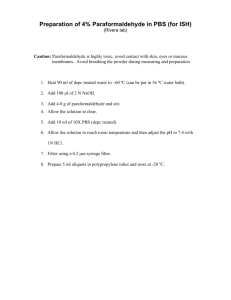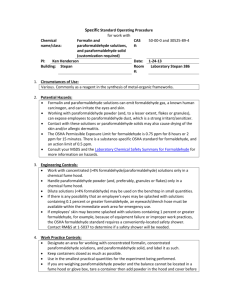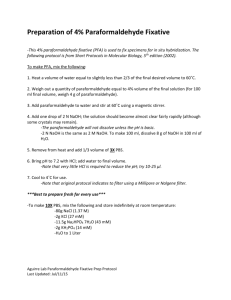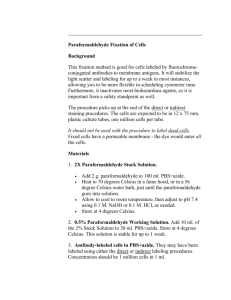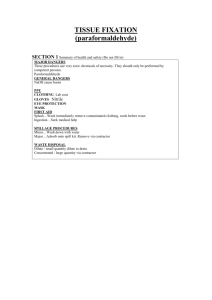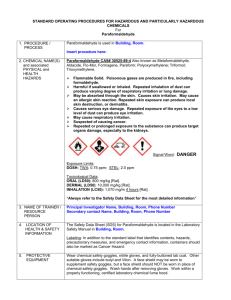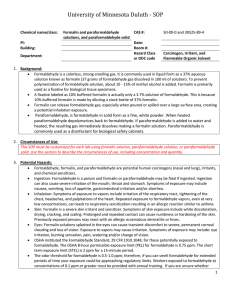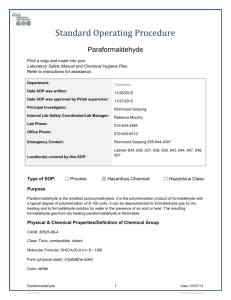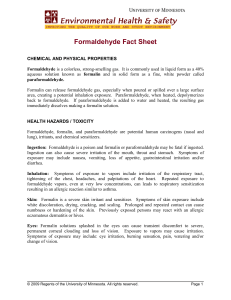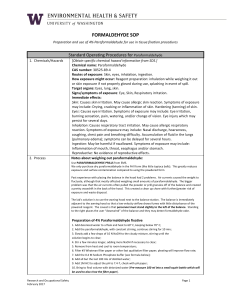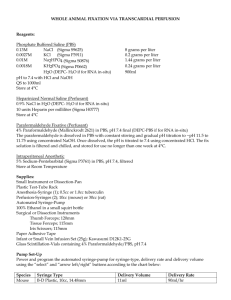Formalin and Paraformaldehyde SOP template
advertisement
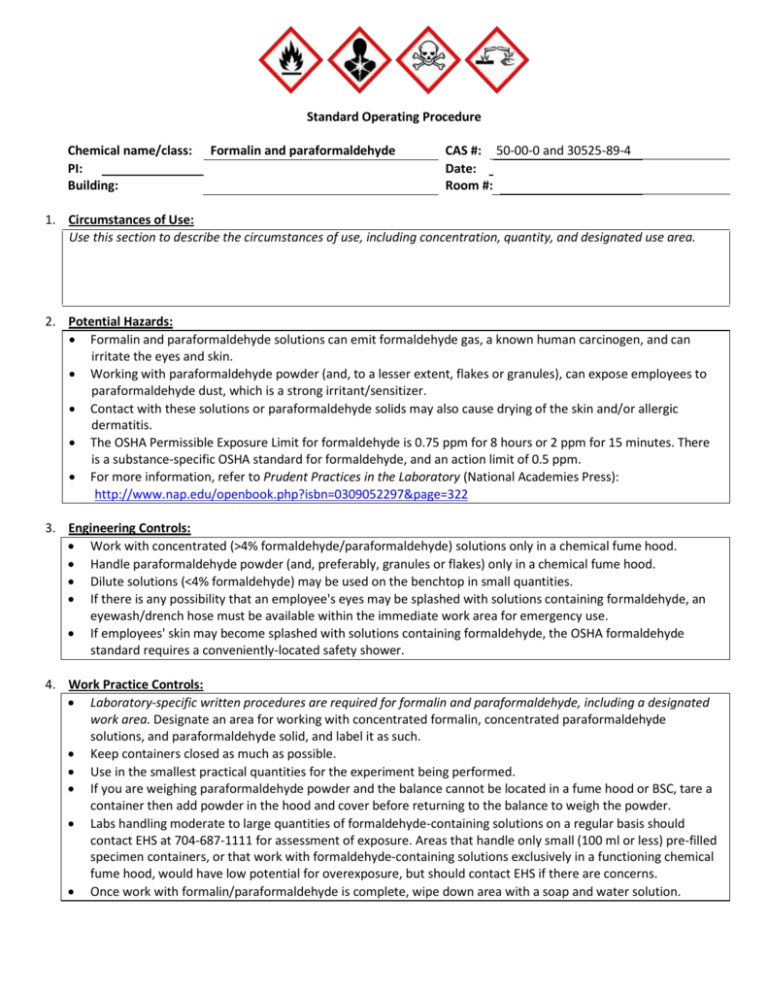
Standard Operating Procedure Chemical name/class: PI: Building: Formalin and paraformaldehyde CAS #: 50-00-0 and 30525-89-4 Date: Room #: 1. Circumstances of Use: Use this section to describe the circumstances of use, including concentration, quantity, and designated use area. 2. Potential Hazards: Formalin and paraformaldehyde solutions can emit formaldehyde gas, a known human carcinogen, and can irritate the eyes and skin. Working with paraformaldehyde powder (and, to a lesser extent, flakes or granules), can expose employees to paraformaldehyde dust, which is a strong irritant/sensitizer. Contact with these solutions or paraformaldehyde solids may also cause drying of the skin and/or allergic dermatitis. The OSHA Permissible Exposure Limit for formaldehyde is 0.75 ppm for 8 hours or 2 ppm for 15 minutes. There is a substance-specific OSHA standard for formaldehyde, and an action limit of 0.5 ppm. For more information, refer to Prudent Practices in the Laboratory (National Academies Press): http://www.nap.edu/openbook.php?isbn=0309052297&page=322 3. Engineering Controls: Work with concentrated (>4% formaldehyde/paraformaldehyde) solutions only in a chemical fume hood. Handle paraformaldehyde powder (and, preferably, granules or flakes) only in a chemical fume hood. Dilute solutions (<4% formaldehyde) may be used on the benchtop in small quantities. If there is any possibility that an employee's eyes may be splashed with solutions containing formaldehyde, an eyewash/drench hose must be available within the immediate work area for emergency use. If employees' skin may become splashed with solutions containing formaldehyde, the OSHA formaldehyde standard requires a conveniently-located safety shower. 4. Work Practice Controls: Laboratory-specific written procedures are required for formalin and paraformaldehyde, including a designated work area. Designate an area for working with concentrated formalin, concentrated paraformaldehyde solutions, and paraformaldehyde solid, and label it as such. Keep containers closed as much as possible. Use in the smallest practical quantities for the experiment being performed. If you are weighing paraformaldehyde powder and the balance cannot be located in a fume hood or BSC, tare a container then add powder in the hood and cover before returning to the balance to weigh the powder. Labs handling moderate to large quantities of formaldehyde-containing solutions on a regular basis should contact EHS at 704-687-1111 for assessment of exposure. Areas that handle only small (100 ml or less) pre-filled specimen containers, or that work with formaldehyde-containing solutions exclusively in a functioning chemical fume hood, would have low potential for overexposure, but should contact EHS if there are concerns. Once work with formalin/paraformaldehyde is complete, wipe down area with a soap and water solution. 5. Personal protective equipment (PPE): Wear standard nitrile laboratory gloves, chemical splash goggles, face shield, close toed shoes, and lab coat. If splash may occur, also wear an impervious apron. (OSHA requires that all contact of the eyes and skin with liquids containing 1 percent or more formaldehyde be prevented by the use of chemical protective clothing made of material impervious to formaldehyde and the use of other personal protective equipment, such as goggles and face shields, as appropriate to the operation 6. Transportation and Storage: Group II – Volatile Toxin Keep container in cool, well-ventilated area. Keep container tightly closed and sealed until ready for use. Store in secondary containment with flammables, away from oxidizers, reducing agents, metals, and acids. Keep containers of PFA solid away from water. Avoid storing on the floor. Avoid ignition sources. Transport formaldehyde solutions in secondary containment, preferably a polyethylene or other nonreactive acid/solvent bottle carrier. 7. Waste Disposal: Formalin and paraformaldehyde solutions and powders must be disposed of following your laboratory-specific procedures and the requirements of UNC Charlotte’s Hazardous Waste Management Practices https://safety.uncc.edu/laboratory-and-research-safety/hazardous-universal-waste. 8. Exposures/Unintended contact: Flush exposed eyes or skin with water for at least 15 minutes, then seek medical attention. If there is respiratory irritation associated with exposure, remove all persons from the contaminated area and contact EHS. Call 911 from a campus phone or 704-687-2200 from any phone to request assistance if needed. Contact the Student Health Center at 704-687-7400 for medical advice on occupational chemical exposures. For an actual chemical exposure, complete the work-related injury or illness report found at: http://safety.uncc.edu/workers-compensation/workers-compensation-section 9. Spill Procedure: Small Spills: Liquids: Employees in the area should be prepared to clean up minor spills, including most spills confined to the chemical fume hood. Wearing double nitrile gloves, splash goggles, face shield and lab coat (and impermeable apron, if available), use absorbent pads to absorb spilled material. Solid Paraformaldehyde: dampen the absorbent pad with methanol before placing over the spilled material and allow to sit for a few minutes before wiping up. After spill has been completely absorbed, wash down contaminated area with soap and water at least two times. Contaminated PPE and clean-up materials must be placed in a clear plastic bag or compatible container for pickup as a hazardous waste. Most spills of formalin or paraformaldehyde solutions, or paraformaldehyde powder that occur outside of a chemical fume hood should be referred to the Campus Police by calling 911 from a campus phone or 704-6872200 from any phone. 10. Training of personnel: All personnel are required to complete the UNC Charlotte EHS Laboratory Environment Training Checklist. This checklist includes an introduction to general chemical safety as well as review of the laboratory specific safety plan. Furthermore, all personnel shall read and fully adhere to this SOP when handling the chemical. “I have read and understand this SOP. I agree to fully adhere to its requirements.” Last First UNC Charlotte ID Signature
